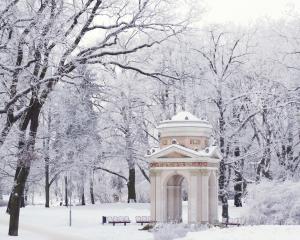
 The exterior of Mausoleum of Galla Placidia. PHOTOS: ELEANOR HUGHES
Mausoleum of Galla Placidia
The exterior of Mausoleum of Galla Placidia. PHOTOS: ELEANOR HUGHES
Mausoleum of Galla Placidia

Ravenna's Mausoleum of Galla Placidia is a simple, brown-brick building, built between AD425 and 450. I wasn’t expecting much inside. According to my guide, Chiara, its simplicity is representative of a good Christian; the exterior of the building like the body, unimportant. What is important is the inside; the precious soul. I enter the doorway.

Galla Placidia, Empress of the Western Roman Empire from AD425 to AD437, wished to be buried here. But if she was, she is no longer. Opened in the 1960s, the three marble tombs within were empty.
Ravenna, in Italy’s Emilia-Romagna region, was capital of the Western Roman Empire, the Ostrogothic Kingdom, and the Byzantine Empire during the 5th and 6th century AD. Every king and emperor during that time built monuments and today, eight of these are Unesco World Heritage sites.
The second, of the five I visit in the old part of the city, is around 150m away.
 The exterior of the Basilica of San Vitale.
Basilica of San Vitale
The exterior of the Basilica of San Vitale.
Basilica of San Vitale

A Byzantine monument, the plain, brown-bricked Basilica of San Vitale was built 100 years after the mausoleum. Between two-storeyed, grey and white swirled marble arches, high arched windows along its octagonal walls beam light on to vibrant, jewel-like scenes. The most famous mosaic, located in an apse, portrays purple-robed Emperor Justinian, a gold brooch on his shoulder, ruler from AD527 to 565. Soldiers and Archbishop Maximianus stand next to him. Opposite, mother of pearl has been used to depict Empress Theodora’s jewels. She stands with her court all wearing richly decorated dresses which look embroidered rather than mosaicked.


I wander the hushed interior, across 16th-century marble, around roped-off 6th-century mosaic floors, and reach two stone stairs surrounding a square, sunken area covered by water. Ravenna was built on a wetland and a water table lies directly below the Basilica. It is thought a chapel holding the bones of Saint Vitale once stood in this square, a small church surrounding it a century before the soaring basilica was built.
Sinners once crawled along the marble labyrinth inlaid before the altar following its white arrows, turning and turning to reach the seashell at the centre, a symbol of purification where paradise is depicted above. Having Chiara explain the meaning behind what I’m seeing adds so much to the overwhelming sights here.

Neonian Baptistery
The circular 10th-century bell tower next to Ravenna’s Cathedral, rebuilt in the 1700s, reminds me of Pisa’s Leaning Tower. In the cathedral’s shadow, the 5th-century, octagonal Neonian Baptistery is Ravenna’s most ancient building and still used for baptisms. Having sunk 3m its original door is unusable. Bar the floor, disused baptismal pool and the Roman stuccos between the windows, the interior is opulently mosaicked. I focus on the intricate detail; the shadowy folds of Apostles’ robes; draping curtains; three-dimensional porticos; the River Jordan’s rippling waters in Christ’s baptisimal scene on the cupola; feet and hands formed with splinters of marble.
 The Archiepiscopal Chapel.
Archiepiscopal Chapel
The Archiepiscopal Chapel.
Archiepiscopal Chapel

Around the corner, the Archiepiscopal Museum, once the Bishop’s Palace dating to the 5th century, is home to the 6th-century Archiepiscopal Chapel. At its entrance, the gold mosaicked ceiling, adorned with jewel-coloured birds and white flowers, glistens. Jesus, fighting for the faith, holds the cross as a sword and a book bearing the words "I am the way, the truth and the life". At his feet lie symbols of evil — a lion and snake. Within the chapel a golden cross glows; historical faces adorn mosaicked arches; 16th-century frescoes replace lost tiles. It was once a private chapel, only bishops viewing its beauty.
We pass many mosaic workshops on a stroll taking us through Piazza del Popolo, Ravenna’s central square. Lined with centuries-old mustard, salmon and pastel-coloured three-storey buildings, its outdoor cafes are busy. The mustard and cream-painted town hall looks over two columns. Atop one is the winged lion, the symbol of St. Mark, on the other Ravenna’s patron, Saint Vitale.

 The exterior of Basilica di Sant'Apollinare Nuovo.
Basilica di Sant’Apollinare Nuovo
The exterior of Basilica di Sant'Apollinare Nuovo.
Basilica di Sant’Apollinare Nuovo

Built in the time of Theodoric, King of the Ostrogoths, Basilica di Sant’Apollinare Nuovo’s lofty nave is airy and bright. Above arches supported by 12 columns, and below arched windows, the life-sized Procession of the Virgins, women in gold mosaicked gowns imitating lavishly embroidered fabric, is opposite white-robed men, the Procession of the Martyrs. The stunning, gold leaf background apparently shimmers in morning light. Above, scenes from Jesus’ life; the Last Supper, crucifixion, resurrection, three wise men and various miracles, are thought to be one of the most ancient, complete representations of his life.
Ravenna’s exterior might be plain but its soul is truly precious.













